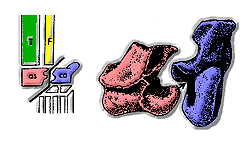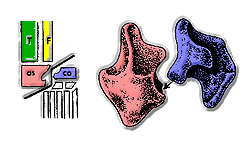Ornithosuchidae
| Ornithosuchidae Temporal range: Late Triassic,
| |
|---|---|

| |
| Venaticosuchus | |
| Scientific classification | |
| Kingdom: | |
| Phylum: | |
| Class: | |
| Infraclass: | |
| (unranked) | Archosauria |
| (unranked) | Pseudosuchia |
| Family: | Ornithosuchidae |
| Genera | |
This article may be too technical for most readers to understand. (July 2011) |
Ornithosuchidae is an extinct family of carnivorous quadrupedal and facultatively bipedal crurotarsan archosaurs. They were geographically widespread during the Carnian and Norian stages of the Late Triassic. Three genera, Ornithosuchus, Venaticosuchus and Riojasuchus are presently known. The family was first erected by German paleontologist Friedrich von Huene in 1914.
Description
Ornithosuchids can be identified by the presence of an arched diastema, or gap between the teeth. When the jaw is closed, two large curved dentary teeth fit into the diastema, which is positioned between the premaxilla and maxilla. There are two shallow depressions on the wall of the diastema to accommodate these teeth. The large dentary teeth of Ornithosuchus and Riojasuchus are placed behind a smaller procumbent dentary tooth that sticks out from the jaw. This type of tooth position is not seen in any other basal archosaurs. Another characteristic feature of ornithosuchids is their unusual downturned, overhanging snout, seen in Riojasuchus and Venaticosuchus, but not Ornithosuchus.[1]
Several other features distinguish ornithosuchids from all other early archosaurs. Ornithosuchus and Riojasuchus both possess a small fenestra, or hole, between the palatine and pterygoid bones of the palate. The contact between the nasal and prefrontal bones of the skull is small or absent, excluded by a large contact between the frontals and lacrimals. In other archosaurs, including rauisuchians, aetosaurs, pterosaurss, and dinosauromorphs, the nasal-prefrontal contact separates the frontal from the lacrimal.[1]
Unlike most other early archosaurs, the pedal unguals (the distalmost bones of the feet that form claws) are laterally compressed. They are sharp and recurved. The unguals are very deep, being taller than they are long, especially on the inner digits. This type of claw is not seen in any other Triassic archosaur except for pterosaurs.[1]
 |
 |
Major archosaur groups have often been distinguised from each other based on the structure of their ankles. In most crurotarsans, the astragalus has a convex projection that fits into a concave space in the calcaneum. This condition is often referred to as a "crocodile-normal" ankle, as it is the most common ankle type in crurotarsans. Ornithosuchids are unique among crurotarsans, and all other archosaurs, in their possession of a "crocodile-reversed" ankle. In a "crocodile-reversed" ankle, the placement of the concavity is reversed: instead of being on the calcaneum, it is on the astragalus. In ornithosuchids, the calcaneum bears a convex projection that is analogous to the convex projection on the "crocodile-normal" astragalus. The "crocodile-reversed" ankle is also seen in Euparkeria, a basal Triassic archosauriform that is classified outside Archosauria.[1]
Phylogeny
Ornithosuchidae is generally considered to be within the larger clade Suchia, which includes aetosaurs, rauisuchians, and crocodylomorphs. Below is a cladogram based on Nesbitt & Norell (2006),[2] Nesbitt (2007),[3] and Brusatte et al. (2010),[4] showing the placement of Ornithosuchidae within Archosauria.
| Archosauriformes |
| ||||||||||||||||||||||||||||||||||||||||||
References
- ^ a b c d Sereno, P.C. (1991). "Basal archosaurs: phylogenetic relationships and
functional implications". Journal of Vertebrate Paleontology. 11 (Suppl. 4): 1–53.
{{cite journal}}: line feed character in|title=at position 49 (help) - ^ Nesbitt, S.J. (2006). "Extreme convergence in the body plans of an early suchian (Archosauria) and ornithomimid dinosaurs (Theropoda)". Proceedings of the Royal Society B. 273 (1590): 1045–1048. doi:10.1098/rspb.2005.3426. PMC 1560254. PMID 16600879.
{{cite journal}}: Unknown parameter|coauthors=ignored (|author=suggested) (help) - ^ Nesbitt, S.J. (2007). "The anatomy of Effigia okeeffeae (Archosauria, Suchia), theropod-like convergence, and the distribution of related taxa" (PDF). Bulletin of the American Museum of Natural History. 302: 1–84. doi:10.1206/0003-0090(2007)302[1:TAOEOA]2.0.CO;2.
- ^ Brusatte, S.L. (2010). "The higher-level phylogeny of Archosauria (Tetrapoda: Diapsida)". Journal of Systematic Palaeontology. 8 (1): 3–47. doi:10.1080/14772010903537732.
{{cite journal}}: Unknown parameter|coauthors=ignored (|author=suggested) (help)
External links




